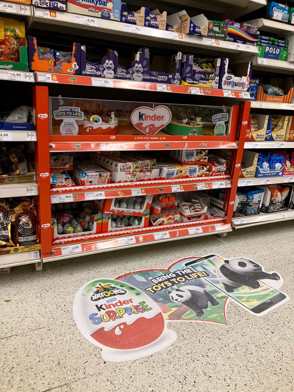Lessons in location: England’s promotion regulations one year on
20 November 2023
Food and drink items which are placed in these special areas are known as location promotions – a calculated retail tactic aimed at increasing the visibility of certain products. And there is an abundance of evidence to show they typically promote very specific types of products - the ones that are bad for our health and that are not needed in a normal healthy diet.
It’s now been over twelve months since the UK Government introduced restrictions on these location promotions for high fat, sugar and salt (HFSS) products, in shops and online, across England (officially implemented 1st October 2022). This means that products that fall within the HFSS category, as determined by the Nutrient Profiling Model, cannot be displayed in prominent locations in shops and their online platforms. The Government was clear that the misalignment between the retail promotions landscape and its own dietary guidelines, as well as the financial barriers promotions pose to healthy food choices, meant action was required.
Scotland faces a similar challenge in its retail environments, as outlined in our latest briefing on HFSS promotions, and the government here has proposed plans to introduce its own version of restrictions. So, in the lead up to potential regulations in the Scottish context, what has unfolded so far with regulations down south?
The Good
Although full evaluation studies are yet to be published, initial figures from retail sales indicate the location promotions restrictions in England may be creating the desired effect. Exclusive findings reported by The Grocer revealed that non-HFSS products generally showed stronger sales results compared to HFSS products in the year up to 30th June 2023. For food categories that saw a decrease in sales, there was a greater decline for HFSS products versus non-HFSS. Perhaps most encouragingly, the category with the biggest difference in sales volume was that of impulse products. Non-HFSS products saw sales growth of 5.6% over the period, whilst HFSS products generated no growth at all. Impulsivity is undoubtedly a key ingredient of location promotion strategies and so this is a significant finding. Similarly positive results were seen for specific food groups including biscuits and crisps, where sales of non-HFSS versions considerably outweighed those classified as HFSS. The Grocer noted that the only category to buck the trend was that of ambient goods (e.g., tinned vegetables, coffee). Overall, these findings suggest that compliant products are taking the place of HFSS products in location promotion spots, resulting in shoppers picking them up more often. If scientific evaluations can back up these initial findings, then there are strong grounds to consider the policy a success.
The Bad
Any policy that creates barriers to the sale of HFSS products, such as this one, naturally carries some incentive for food producers to design healthier offerings that will not face regulation. At least, that’s the idea. Unfortunately, there is some evidence that food companies are instead actively exploiting gaps in the legislation relating to location promotions, or ignoring it altogether, in a bid to continue business as usual. Below are some examples taken from Twitter/X posted by keen-eyed shoppers in recent months.

Image on left posted 15th October 2023. Image on right posted 13th October 2023.
The image on the left shows a mid-aisle location promotion exclusively displaying products for a single brand (a brand mainly associated with HFSS products). Concerningly, the promotion is focused towards the lower levels of the shelves which could easily capture the attention of young children. It’s important to note that, despite this example not being within the spirit of the promotion restrictions and wider public health, mid-aisle displays are not restricted by the legislation. The image on the right, however, appears to show complete disregard for the legislation which does identify end-of-aisles as being a restricted promotional location.
Of course, we can’t say for sure how wide spread such examples are in the retail sector, but both of these images provide real evidence that the industry continue to use strong marketing techniques for HFSS foods.
The Unknown
Research and evidence providing further details of the policy’s impact is expected soon. The early sales data suggests it may be working well by encouraging retailers and shoppers towards healthier offerings. However, the full impact of the legislation is unlikely to be achieved without consistent adherence throughout all retail spaces.
These findings can help inform the Scottish Government when drafting its own legislation for restriction of location promotions. Regulations that can stop the incessant in-store marketing of HFSS food and drink are needed alongside enforcement and evaluation. This is a rare and valuable opportunity to make a real difference to our shopping environments and support people to make the healthier choice.
To find out more about HFSS promotions and what we believe evidence-based regulations should look like, read our position statement.
 Price & Promotions
Price & Promotions
 Position Statement on Price and Location Promotions of high fat, salt and sugar (HFSS) products - November 2023
Position Statement on Price and Location Promotions of high fat, salt and sugar (HFSS) products - November 2023
